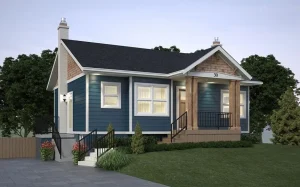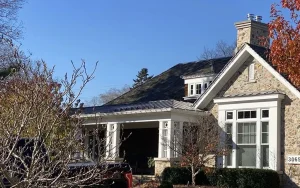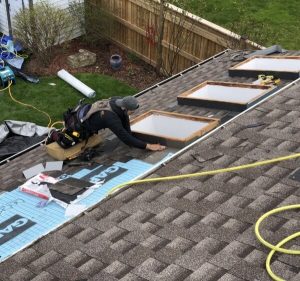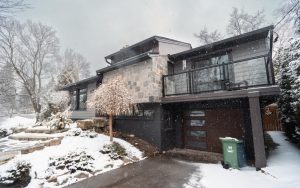2025 Ontario Roof Replacement Cost: Roof Type & Prices
Oct 9, 2025

In 2025, the average roof replacement cost in Ontario ranges from $6,500 to $18,000, depending on roof size, slope, and material. Roofing material prices have risen 8–12%, while labour often makes up 40–60% of the total. Asphalt shingles are the most cost effective, while slate and metal roofing can more than double the final price. For more detailed insight by roof type, size, and material, read this full guide on roof replacement cost.
How Much Does It Cost to Replace a Roof in Ontario Now
Roof replacement cost is a topic that rarely has a one-size-fits-all answer. On average, Ontario homeowners in 2025 can expect to pay between $6,500 and $18,000 for a typical residential roofing project, though more complex designs or premium materials can push the price much higher. The cost per square foot ranges from $3.50 to $9.00, depending on the roofing material chosen, the slope, and whether an old roof tear-off is required.
Average roof replacement cost per material and size
To put this into perspective, here’s a look at current averages:
| Roofing Material | Cost per Square Foot | Average Total Cost (1,500 sq ft) | Expected Lifespan |
|---|---|---|---|
| Asphalt Shingles | $3.50 – $5.50 | $5,250 – $8,250 | 15–20 years |
| Metal Roofing | $7.00 – $9.00 | $10,500 – $13,500 | 40–50 years |
| Slate Roof | $9.00 – $14.00 | $13,500 – $21,000 | 70+ years |
| Flat Roofs | $4.00 – $6.00 | $6,000 – $9,000 | 15–25 years |
| Cedar Shakes | $6.50 – $8.50 | $9,750 – $12,750 | 25–30 years |
| Green Roof | $12.00 – $18.00 | $18,000 – $27,000 | 30–50 years |
Most homeowners gravitate toward asphalt shingles due to their cost effectiveness, but growing demand for energy efficient solutions has made metal roofing increasingly popular. Local roofing contractors note that weather conditions and regional building codes also affect these prices, since improper installation in extreme weather can lead to costly repairs.
Roofing Material Breakdown and What Homeowners Pay in 2025
Asphalt shingles
Still the most popular choice for Ontario homeowners, asphalt shingles are valued for their upfront cost savings. They typically run $3.50–$5.50 per square foot, making them affordable for most budgets. However, frequent maintenance may be required , and the average lifespan rarely exceeds 20 years.
Metal roofing
The cost of a metal roof averages $7–$9 per square foot, which is almost double asphalt. But with a lifespan of 40–50 years and low maintenance needs, many consider it a long-term cost saving solution. Energy efficiency is another advantage — metal reflects sunlight, helping to keep cooling bills lower during hot summers.
Slate roof
Premium materials like slate represent a significant investment, often $9–$14 per square foot. While the upfront cost is steep, slate roofs can last well over 70 years if properly installed, making them ideal for homeowners who want durability and curb appeal.
Flat roofs
Common in urban and commercial properties, flat roofs cost about $4–$6 per square foot. They’re cost effective initially, but require more maintenance and have a shorter average lifespan compared to pitched roofing.
Cedar shakes
Known for their natural look and texture, cedar shakes are priced around $6.50–$8.50 per square foot. They provide excellent insulation but require more maintenance and frequent treatments against rot and insects.
Green roofs
An intensive roof option, green systems range from $12–$18 per square foot. They provide unmatched energy efficiency and curb appeal, but project complexity and local regulations make them suitable for only a select group of homeowners.
Factors That Affect the Final Cost of Replacing Your Roof
Roof replacement is rarely just about swapping out old shingles for new ones. The final cost depends on several factors that vary greatly depending on your home’s design, the roofing contractor’s approach, and local weather conditions.
Roof shape and multiple slopes
Complex roof shapes with hips, valleys, and multiple slopes increase waste and labour. A simple gable may add 10–15% more shingles, but a cross-gabled design can push material use up by 30%. Precision cutting and sealing also extend project timelines, which raises labour costs by 15–25% on average.
Roof pitch and steeply pitched roof
Steeper roofs cost more due to safety measures and slower installation. A roof with a 9/12 pitch or higher can increase replacement costs by 20–30%. Crews need scaffolding, harnesses, and extra equipment, while shingles and underlayment require careful fastening. Ontario’s snow-heavy winters make steep pitches common, but that also means higher labour bills.
Structural damage and old roof issues
Hidden problems like rotting sheathing, mould, or damaged trusses can add $1,000–$4,000 to a project. Replacing sheathing alone costs about $2–$4 per square foot. If multiple layers of old shingles are present, full tear off is required under building codes, adding $1,000–$1,500 in disposal and labour fees.
Roof size and design
Roof size sets the baseline cost, but design complexity changes everything. A 2,000 sq ft gable roof might cost less than a 1,500 sq ft roof with dormers and skylights. Features like chimneys or vents require cutting and flashing, adding several hundred dollars. More surface area also means higher material and safety costs overall.
Do Ontario Roofing Contractors Include Disposal Fees and Permits
Most roofing contractors in Ontario include disposal fees and building permits in their quotes, but not all roofers are transparent about the details. Homeowners should always ask if dumpster rental, landfill charges, and permit applications are built into the estimate. These fees can add $500–$1,500 to the overall cost of a roofing project.
In practice, municipal building codes require permits for structural changes or full roof replacements. While the roofing contractor often handles the paperwork, some charge separately for it. Disposal fees are another hidden cost. Old shingles, nails, and underlayment are heavy, and disposal can cost $100–$150 per ton. For a full tear-off, expect two to four tons of debris.
Ontario homeowners should request itemised estimates to avoid surprises. Getting multiple quotes helps confirm if fees are fairly included, since project complexity and local regulations vary greatly depending on location.
The Truth About Labour Costs and Roofing Project Timelines
Labor costs account for a significant portion of total roof replacement cost, often 40–60% of the final bill. The size of the roof, its pitch, and the roofing material all influence labour rates. Asphalt shingles may take two days to install, while slate or metal roofing can extend timelines by a week or more.
Roofing contractors typically charge $1.50–$3.50 per square foot in labour. Steeply pitched or multi-sloped roofs demand more time, scaffolding, and safety equipment, pushing labour costs higher. Weather conditions also affect project timelines. Heavy rain or extreme heat slows crews down, sometimes doubling completion time.
Homeowners often overlook these variables. A 1,500 sq ft roof might be finished in three days under ideal conditions, but with structural damage or complex design, the same project can take twice as long. This makes labour costs one of the least predictable yet most influential factors in roof replacement.
Removing an Old Roof Isn’t Always a Better Choice
Many homeowners assume tearing off the old roof is the only way forward, but that isn’t always true. Overlaying a new roof on top of existing shingles can save $1,000–$2,500 in tear-off and disposal fees. However, this shortcut isn’t always recommended and is restricted by most building codes in Ontario.
The main issue is improper installation risk. Multiple layers add weight, which can stress trusses and reduce roof lifespan. Moisture trapped between old and new shingles can also lead to rot and structural damage. While overlaying is cheaper upfront, it often creates higher costs down the road.
Roofing contractors must inspect for hidden damage before deciding. If the sheathing or underlayment is compromised, overlaying is a false economy. Most roofers prefer a full tear-off because it ensures proper installation and longer roof’s lifespan — even if it means a higher upfront cost.
Should You Replace Your Roof Before or After Winter
The best time for roof replacement in Ontario depends on balancing weather conditions, contractor availability, and pricing. Fall is typically the most recommended season. Temperatures are moderate, weather is stable, and shingles seal properly. Winter replacements are possible but involve more material waste and higher labour costs.
Replacing a roof before winter ensures your home is protected from snow loads and ice dams. Contractors can complete projects faster in fall, and the final price is often lower due to fewer delays. However, scheduling in peak autumn season may require booking months in advance.
Spring replacements are common too, though weather can be unpredictable. Sudden rains may extend timelines and increase labour costs. While some homeowners wait until after winter to see if leaks develop, roofing experts warn this approach risks further structural damage and higher repair bills. Choosing the right timing can save from additional costs and prevent bigger problems.
Professional Roof Installation Is Not a DIY Weekend Job
Replacing a roof is not the same as repainting a room or fixing a fence panel. It’s a complex, labour-intensive project that requires technical skill, proper installation methods, and compliance with building codes. To show the difference, let’s look at DIY roofing vs hiring professional contractors, along with real cost examples.
DIY roof replacement and hidden costs
Some homeowners consider tackling roof replacement themselves to save money. At first glance, it looks cheaper — materials for asphalt shingles can cost $3,500–$5,000 for an average 1,500 sq ft roof. However, hidden costs quickly add up. Renting scaffolding, safety harnesses, and disposal bins can add another $1,000–$2,000.
The bigger issue is risk. Without training, it’s easy to make mistakes like improper flashing, poor sealing, or uneven shingle lines. Improper installation often leads to leaks, voided warranties, and reduced energy efficiency. In the long run, a DIY roof replacement can cost homeowners 30–40% more once repairs are factored in.
Professional roof installation and cost ranges
Professional contractors bring expertise, safety equipment, and workmanship warranties. They also complete projects more efficiently. While labour is a significant portion of the bill, it ensures the job is done right the first time.
Here’s what homeowners can expect in 2025:
| Roofing Material | Average Material Cost (per sq ft) | Average Labour Cost (per sq ft) | Total Installed Cost (1,500 sq ft roof) |
|---|---|---|---|
| Asphalt Shingles | $3.50 – $5.50 | $1.50 – $2.50 | $7,500 – $12,000 |
| Metal Roofing | $7.00 – $9.00 | $2.50 – $3.50 | $14,250 – $19,500 |
| Slate Roof | $9.00 – $14.00 | $3.00 – $4.50 | $18,000 – $28,500 |
| Cedar Shakes | $6.50 – $8.50 | $2.00 – $3.00 | $12,750 – $17,250 |
| Flat Roofs | $4.00 – $6.00 | $1.50 – $2.50 | $8,250 – $12,750 |
A properly installed roof lasts its full lifespan — 20 years for asphalt, 40–50 years for metal, and 70+ years for slate — while DIY mistakes can cut that lifespan in half.
Roof Renovation and Replacement Options
Roof renovation isn’t always limited to tearing off old shingles and starting fresh. For some homeowners, partial roof repairs or overlays are viable solutions. Renovation may include replacing damaged sections, improving ventilation, or upgrading flashing around chimneys and skylights. These adjustments can extend the lifespan of the existing roof while postponing the cost of a full replacement.
Replacement, however, becomes the only realistic choice when there are widespread leaks, structural damage, or multiple layers of old shingles. Modern replacement options are more versatile than in the past. Homeowners can choose asphalt shingles for cost effectiveness, metal roofing for durability, or slate and cedar shakes for curb appeal. Flat roof replacements remain common for commercial buildings, with green roof systems increasingly used on new residential builds for energy efficiency.
Deciding between renovation and replacement depends on roof age, condition, and long-term goals. While renovation may save money in the short term, replacement provides greater protection, energy efficiency, and compliance with building codes.
Financing Options for Roof Replacement in 2025
The cost of a new roof is a significant investment, often ranging between $7,500 and $25,000 depending on roof size, material, and project complexity. For many homeowners, financing options make the process manageable without straining monthly budgets.
Several financing methods are available:
- Home equity loans or lines of credit: allow borrowing against existing home equity, usually with lower interest rates.
- Personal loans: flexible but often carry higher interest compared to secured loans.
- In-house contractor financing: many roofing companies partner with financial institutions to offer structured payment plans.
- Government programs: rebates and incentives may apply for energy efficient roofing materials, especially when upgrading insulation or ventilation systems alongside replacement.
Financing spreads out the upfront cost and allows homeowners to invest in premium materials that offer longer lifespans. For example, financing a $15,000 metal roof over 10 years could cost $150–$200 per month, while reducing frequent maintenance costs compared to asphalt shingles.
Finding the Balance Between Upfront Cost and Roof’s Lifespan
Every roofing project involves weighing upfront cost against long-term value. Asphalt shingles might seem cost effective initially at $7,500–$12,000 for a standard home, but their 15–20 year lifespan means replacement may be needed sooner. By contrast, slate or metal roofing demands a higher upfront cost of $15,000–$25,000, yet provides 40–70 years of service with minimal maintenance.
The balance comes down to more than just material prices. Energy efficiency, curb appeal, and resilience to extreme weather should all be factored in. A metal roof may cost more per square foot, but it helps save money on cooling bills in summer, while slate can increase resale value because of its longevity and premium look.
Homeowners who plan to stay in their property for decades often find higher-end materials more cost effective in the long run. Those planning to sell sooner may prefer budget-friendly solutions, provided they meet safety and building code requirements.
How Our Roofing Contractors Can Help
Replacing a roof is a complex project shaped by roof size, design, pitch, weather conditions, and the right roofing material. From the first inspection to the final price, a qualified roofing contractor ensures proper installation, compliance with local building codes, and safety measures that protect both workers and your property.
Whether you’re considering asphalt shingles for affordability, metal roofing for durability, or premium slate for a significant investment, professional guidance is essential. Not all roofers include disposal fees, permits, or workmanship warranties in their estimates — requesting multiple quotes helps you make an informed decision.
A skilled roofing contractor in Hamilton can help you balance upfront cost with long-term performance. With proper installation, you avoid common issues like leaks or premature wear, reduce the need for frequent maintenance, and extend your roof’s lifespan, making the investment truly cost effective.
FAQ About Average Roof Replacement Costs in Ontario
1. What drives up the cost of a new roof for Ontario homeowners?
Major cost drivers include steep roof pitch, multiple slopes, hidden structural damage, local permitting fees, and disposal of old roofing. Material choice also matters: premium materials like slate or metal add significantly more than asphalt. Labour intensity and weather delays further inflate the final cost.
2. How much extra does removing an old roof add?
Tear-off and disposal typically add $1.00 to $2.50 per square foot depending on number of layers. For a 1,500 sq ft roof, expect an additional $1,500 to $3,750. That’s why many contractors insist on full removal rather than overlays.
3. Can overlaying shingles save money without issues?
Overlaying (adding new shingles over old ones) may reduce initial costs, but it can trap moisture, increase weight, and shorten roof lifespan. Many Ontario building codes now require full tear-off for proper warranty eligibility. It’s rarely recommended unless the underlying deck is pristine.
4. How much of total cost is labour vs materials?
Labour often represents 40–60% of the total cost. In Ontario, roofing labour alone might run $2.50 to $5.00 per square foot, varying with pitch, height, and complexity. Complex roofs or difficult access can push labour’s share even higher.
5. Does timing (before vs after winter) affect cost?
Absolutely. Installing a roof before winter usually costs less, because mild temperatures let shingles seal properly. Winter or early spring replacements risk delays, material waste, and frozen surfaces — often raising final cost by 10–20%.
6. Why do quotes for the same roof vary so much?
Differences in contractor overhead, warranty offerings, subcontracting, local labour rates, and inclusion of disposal/permit fees lead to wide variance. One contractor may offer rock-bottom material costs but skimp on safety or permit compliance — get detailed, itemized quotes.
7. Does roof replacement cost vary much by material in Ontario?
Yes — material choice dramatically influences cost. Asphalt is the most affordable. Metal, cedar shakes, and slate can be 2–4× more expensive per square foot, due to heavier materials, more labour, and structural reinforcement requirements.




